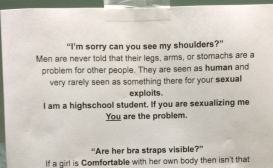COMMENTARY: Student dress code controversy sparks new discussion at BHS

Dress code commentary flyer posted anonymously in women’s restroom
On Sept. 19 an anonymous and unapproved flyer was posted in the women’s bathrooms at BHS. This poster featured the idea that the student dress code specifically targets the female student body, as well as commenting on the issue of female students being sexualized. This sparked a new discussion about the dress code at BHS, and I’m here to share a few thoughts about the ordeal.
I would like to begin this by saying, whether I agree with the ideas on the anonymous poster or not, I don’t believe putting unauthorized flyers around the school was a respectful or productive way to share the message. BHS is lucky because there are quite a few channels through which students can discuss issues they have, such as the Student Advisory Team or scheduling a meeting with an administrator.
Moving onto the issue at hand, I can understand both perspectives facing the dress code. Some believe that the dress code treats female students unfairly and limits freedom of expression, while others think that a strict dress code is necessary in maintaining the educational atmosphere and not distracting other students. To that I would say, how is a girl’s shoulder distracting?
It is too often that the excuse for not allowing girls to wear thin strapped tank tops or dresses is that showing their shoulders exposes too much skin, and can then be distracting for male student. Personally, I see that as problematic, similarly to how I believe the saying, “boys will be boys” is problematic. I don’t believe it should be a woman’s responsibility to hide themselves in order to not be a distraction to men. I believe I have a unique perspective on this, being someone who is attracted to both guys and girls. Not once have I found a tank top on a girl distracting, and even if I had, it would have been my responsibility not to let such a small thing distract me.
On the other hand, I certainly see the difficulties with a less strict dress code, especially from the perspective of staff and administrators whose job it is to regulate what students wear to school. It can be an uncomfortable situation to have to tell a student what they’re wearing is not appropriate, and the line can often appear very blurred. Whereas, some facets of the dress code, such as clothing featuring suggestions of illegal drugs, are clearly unacceptable, it is rarely so easy to make decisions without pulling out a ruler and measuring short lengths and tank top widths.
Overall, I believe this discussion about the dress code is an important one to have. It opens up a productive dialogue between students and staff about an issue many students believe to be important. I don’t think that there is any hard line to be drawn or decision to be made at the moment, but if the discussion continues to happen, I think that the dress code can certainly be made better and more comprehensive for everyone at BHS.

